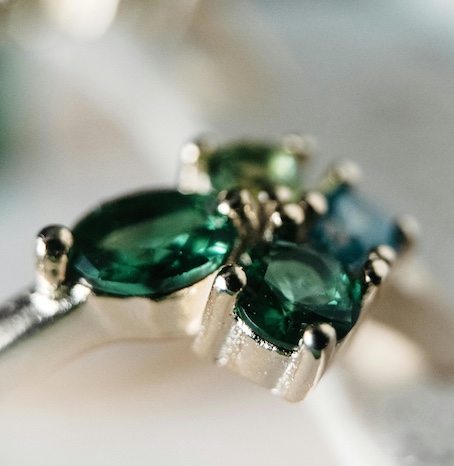Gemstones & Mood: How Colour Can Influence Everyday Style

26-11-2025
In fashion, colour is one of the fastest ways to communicate brand identity, seasonal direction and emotional intent. The same applies at the micro level of accessorising. Gemstones don’t just change how jewellery looks they shift how a garment reads, how a silhouette feels and how a collection’s narrative comes together. The right hue can activate a runway look, elevate a street-style moment, or reinforce a label’s design codes. Here we’ll look at how gemstones help fashion creatives and style-savvy consumers “tune” an outfit’s mood from dopamine inducing brights to quiet luxurious neutrals.

1) The psychology of colour in fashion
Colour psychology underpins trend forecasting, campaign styling and even retail merchandising and jewellery plays directly into that system. Saturated reds feel bold and extroverted on the catwalk; cool blues communicate clarity and composure in editorial styling. The ongoing “dress-yourself-happy” movement across social platforms mirrors what designers have long known: purposeful colour choices influence confidence, emotion and the perceived energy of an outfit. For stylists and designers, gemstone colour becomes another tool to deliberately craft these emotional impressions.
2) Gemstone colours and personal meaning
Gemstones express these colour messages through materiality.
- Reds (ruby, garnet) align with themes of passion, strength and vitality, ideal for looks that need visual courage or a focal accent.
- Blues (sapphire, topaz) suggest calm, trust and composure, strong for officewear capsules or minimal tailoring edits.
- Greens (emerald, peridot) emphasise balance, renewal and growth, useful in collections exploring nature, sustainability or organic forms.
Guides for first-time gemstone buyers often recommend choosing a stone that “feels right” both for personality and palette. If you lean toward uplifting warmth, try citrine or morganite; if your aesthetic is more contemplative or artisanal, look to lapis or tanzanite. For designers, these choices become powerful storytelling devices in lookbooks and close-up accessory shots.
3) How to wear colour jewellery every day
Treat coloured gems the way a stylist treats a strategic knit or printed scarf: use them to reinforce or intentionally disrupt the palette.
- Casualwear: A turquoise pendant or a stack of green-gem rings adds freshness and texture to denim, workwear silhouettes or crisp shirting.
- Workwear: Navy tailoring pairs cleanly with cool blues or smoky greys, keeping the look authoritative yet modern.
- Layering: Even when paired alongside diamond rings, colour-accent pieces bring dimension. Think a sapphire line bracelet styled next to a classic solitaire, or an emerald charm layered with a minimalist gold chain.
For fashion creatives, coloured gems offer a compact way to introduce seasonal tones without redesigning an entire wardrobe or collection.
4) Choosing the right colour for your mood, occasion & skin tone
Here’s a quick, stylist-friendly framework:
Mood & message
- Big meeting / client presentation: Cool blues and deep greens project calm authority.
- Evening or event styling: Ruby, spinel or amethyst deliver drama and presence under low lighting.
- Everyday lift: Citrine, peridot or pink tourmaline add upbeat brightness that reads fresh in daylight.
Occasion
- Daywear: Smaller stones, brushed metals and low-profile settings look polished while staying understated.
- Events & red carpet: Bolder cuts, saturated colour and faceted sparkle perform beautifully under camera flashes and spotlights—think emerald-cut sapphires, rich garnets or tanzanite drops.
Skin tone & undertone
Seasonal colour analysis remains a useful styling reference:
- Warm undertones glow with yellow gold, corals, olives and earthy greens.
- Cool undertones pair best with silvers, icy blues and jewel-tone purples.
Gemstone colour is one of the most impactful yet low-effort ways to align what you wear with the mood or story you want to project. Start with a single hue that captures your current aesthetic direction, then build a small rotation for work, weekend and event styling. In fashion design, these choices aren’t just decorative, they’re emotional cues, storytelling tools and branding assets all at once.
Images by Lisa from Pexels and Jacqueline Kabrel via pexels.com























